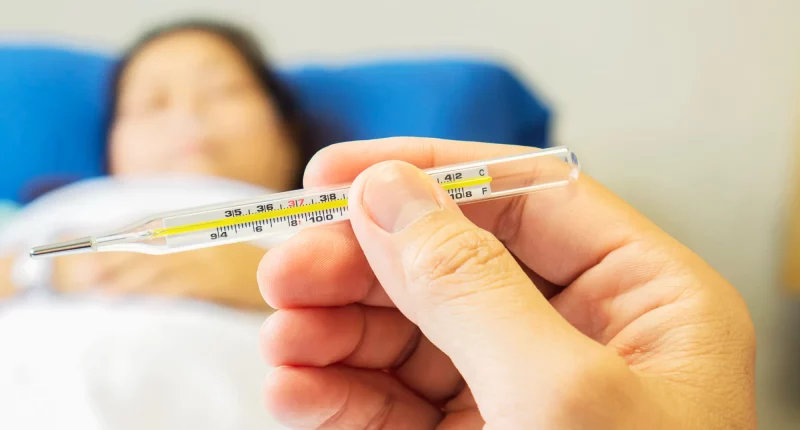Campylobacter infection is a stomach infection caused by bacteria called Campylobacter. It’s often known as food poisoning.
This infection usually happens when people eat undercooked meat, like chicken, or beef, or consume produce that hasn’t been properly washed.
The bacteria primarily affect the small intestine, leading to various digestive symptoms.
What is it?
Campylobacter infection is a common type of intestinal infection caused by Campylobacter bacteria. As stated by the Centers for Disease Control and Prevention, these bacteria are the leading cause of bacterial diarrheal illness in the United States, affecting approximately 1.5 million individuals every year.
The bacteria can be found in the milk or meat of animals and can contaminate water or produce through contact with feces or infected meat. When people consume these contaminated foods, they may develop symptoms like stomach cramps, bloody diarrhea, and fever.
The World Health Organization notes that most infections are mild and resolve on their own. However, young children, older people, and individuals with weakened immune systems have a higher chance of developing more illnesses.
Symptoms
The symptoms of Campylobacter infection usually appear 2 to 5 days after a person becomes contact with the bacteria, though this period can range from 1 to 10 days. Common symptoms include fever, diarrhea, stomach cramps, headaches, nausea, and vomiting.
These symptoms typically last between 3 to 6 days.
Causes
Campylobacter infection occurs when an individual is infected with Campylobacter bacteria. According to the World Health Organization, these bacteria are commonly found in various animals, including poultry, cattle, pigs, sheep, shellfish, and ostriches. They may also be present in pets like dogs and cats.
The primary way people get infected is by consuming undercooked meat. During the slaughtering process, bacteria from the animal’s feces can infect the meat. Other sources of infection include consuming contaminated ice or water, raw milk, and unwashed vegetables and fruits. Milk can become contaminated if bacteria exist in the animal’s udder, and fruits and vegetables can become contaminated through contact with water or soil that contains animal feces.
In rare cases, people can contract the infection by coming into contact with contaminated water during recreational activities like swimming. Streams and lakes can be contaminated with animal feces, posing a risk of infection.
Treatment
Treatment for Campylobacter infection mainly involves managing symptoms and replacing fluids lost due to vomiting and diarrhea. It is important for individuals with the infection to drink extra fluids to prevent dehydration.
In most cases, antibiotics are not required. However, they may be prescribed if the individual is severely ill or at risk of developing a severe illness. This group includes individuals over 65 years old, pregnant individuals, and those with weakened immune systems.
Diagnosis
To diagnose food poisoning, including Campylobacter infection, a healthcare professional typically looks at an individual’s medical history and symptoms. This means they will ask about what symptoms the person is experiencing, such as diarrhea, stomach cramps, or fever, and any recent food they may have eaten that could have been contaminated.
For a more accurate diagnosis of Campylobacter infection, a laboratory test is needed. This involves taking a sample of stool (feces), bodily fluids, or tissue from the person. The sample is then tested in a lab to see if the Campylobacter bacteria are present. If the test is positive, it confirms the diagnosis of Campylobacter infection.
Prevention
Even though the Food and Drug Administration and the U.S. Department of Agriculture regulate poultry and meat, there are additional preventive measures individuals can take at home to decrease the risk of Campylobacter infection.
The only effective method to rule out Campylobacter bacteria in food is through proper cooking. People typically contract this bacterial infection by eating raw meat. To prevent this, it is crucial to cook meat to the appropriate internal temperature.
Preparation and Storage of Safe Food
Assume that all raw meat is potentially contaminated and manage it carefully. To prevent Campylobacter infection, follow these practices:
- At the grocery store, wrap meat in plastic covers to keep its juices from spilling onto other foods.
- Thoroughly clean food preparation surfaces and cutting boards instantly after use to prevent cross-contamination with other food items.
- Refrigerate meat instantly after purchasing it.
- Wash products well before eating.
- Wash hands thoroughly with water and soap after cleaning raw meat, as well as after playing with pets, utilizing the bathroom, or getting in contact with used diapers.
These steps help minimize the risk of infection and ensure safe food handling practices at home.
Complications
Some individuals may face complications from Campylobacter infection. These complications can include arthritis, irritable bowel syndrome, and temporary paralysis. In people with weak immune systems, the bacteria can enter the bloodstream, which can be dangerous.
Even though very uncommon, Campylobacter infection can lead to Guillain-Barré syndrome. This is a condition where the immune system mistakenly triggers the nerves, causing muscle weakness and, in many episodes, paralysis that can last for many days. According to the CDC, about 1 in 1,000 individuals who contract a Campylobacter infection develop GBS. In fact, Campylobacter bacteria may be responsible for up to 40 percent of GBS cases.
Most individuals recover fully from GBS, although the process can take some time.
Outlook
Many individuals with Campylobacter infection start feeling better within a week. However, during this time, symptoms like diarrhea, stomach cramps, and fever may persist.
It’s crucial to drink plenty of fluids while recovering from this infection to prevent dehydration. This means drinking water, oral rehydration solutions, or clear broths to replace the fluids lost due to diarrhea and vomiting. Staying hydrated helps the body recover more quickly and can ease some of the symptoms.
When to Contact a Healthcare Provider
It is important to contact a healthcare provider if you experience certain symptoms while suffering from Campylobacter infection. These symptoms include fever, persistent stomach pain, diarrhea lasting more than two days, or diarrhea with blood.
Additionally, get medical attention if you show symptoms of dehydration, such as lethargy, dry mouth, or reduced urination.
Caregivers and parents should also meet healthcare providers if a child under 12 months old develops symptoms of Campylobacter infection.
Summary
Campylobacter infection is a common intestinal infection caused by Campylobacter bacteria, often contracted through undercooked meat or contaminated food and water. Symptoms typically appear 2–5 days after infection and can include diarrhea, fever, and stomach cramps.
Most people recover within a week with proper hydration, but complications such as irritable bowel syndrome, arthritis, or even Guillain-Barré syndrome can occur, particularly in those with weakened immune systems. It is essential to contact a doctor if symptoms are severe, or persistent, or if signs of dehydration are present. Children under 12 months with symptoms should also see a doctor.








